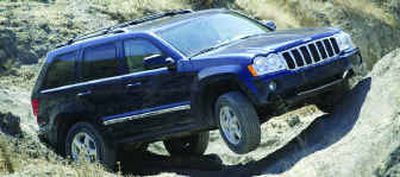New Grand Cherokee remains all-Jeep

Finding itself at the crossroads, Jeep has gone down a familiar, if less-taken path.
Since its introduction in 1993, Jeep’s Grand Cherokee has reigned as the iconic go-anywhere American SUV. Designed to combat Ford’s then-new Explorer, the Grand Cherokee married power, luxury and off-road utility to became the rig of choice for those who were, in fact, likely to drive their sport-utes to both the opera and the fishing hole.
Jeep says 25 percent of Grand Cherokee owners drive theirs off-road, a figure that towers like Everest above the industry average.
But the advent of a generation of car-based competitors has deeply impacted Grand Cherokee sales. The so-called crossover rigs offer car-like ride and handling and room for up to eight, while the Grand Cherokee rides on a truck-style chassis and can manage only four occupants.
When it came time to design the third-generation 2005 Grand Cherokee, Jeep product planners faced a choice. Should they abandon the strategy that had served them well but faced new challenges, or stick with the tried and true?
To the relief of devotees, they went with the tried and true.
The 2005 Grand Cherokee is the most sophisticated, capable and strongest Grand Cherokee yet. A new suspension yields improved road performance, with no loss of off-road capability; rack-and-pinion steering replaces the old recirculating-ball setup for improved feel and responsiveness; and new brakes produce shorter, more controlled stops.
Chrysler’s well-advertised Hemi-style V-8 is one of three available power plants and buyers can choose between three new full-time four-wheel-drive systems.
But, when all is said and done, the Grand Cherokee still rides atop what is essentially a truck platform, with all the ride-and-handling limitations that implies, and still has room for only four.
This would appear to fly in the face of logic, except that Jeep:
1) Has built its brand identity on the reality, not the myth, of off-roading; it’s integral to the company’s DNA and has produced one of the most loyal owner groups in the industry.
2) Is developing two new vehicles — an eight-passenger rig to be called the Jeep Commander and an as-yet unnamed new crossover, or “soft-ute,” that will ride on a car-based platform.
Makes sense to me.
Perhaps intending to draw a line in the sand between the Grand Cherokee and the crossovers, Jeep designers flattened the exterior planes and squared off the wheel wells for a boxier, more upright stance. The familiar seven-slot grille is flanked by round headlights, a design cue that will be a Jeep hallmark for the foreseeable future.
The Grand Cherokee rides 2 inches lower and the beltline has been raised and the windows shortened. The hood slopes more dramatically, offering improved visibility when crawling over rocks and stumps.
Shorn of its trademark lower-body cladding and sporting color-keyed fascias, the new Grand Cherokee projects a more mature image.
The wheelbase has grown 3 inches to 109.5 and overall length is up by a like amount, although passenger space has grown only by an inch in width. Ground clearance has been reduced from 8.9 inches to 8 even.
To preserve the Grand Cherokee’s off-road capabilities, Jeep designers have maintained segment-best angles of approach and departure, as well as outstanding break-over numbers — the key ingredients for successful off-roading.
Opera-bound occupants will appreciate the interior’s new upscale ambience. Materials are improved and fit-and-finish is better. Chronometer-style gauges are a handsome touch and the feel of the switchgear is dramatically improved. The front seats are more supportive this year, but the back seats are still too small, too close to the floor and too cramped.
A new, independent front suspension and new steering system produce a more responsive driving experience and a wider track produces a more stable feel on the road.
Despite its height, the Grand Cherokee glides through high-speed curves with minimal lean. An optional Dynamic Handling System hydraulically adjusts the stabilizer bars to further reduce body roll and improve overall handling.
Long-suspension travel, a key to off-road capability, exacts a price on the road, where it tends to allow a rig to float over certain road-surface irregularities. Jeep engineers have done a remarkable job of minimizing the effect.
The three new four-wheel-drive systems are meant to sync up with users’ needs, from a transparent always-on system best suited for public roads, to a pair of systems tailored for off-roading. The base configuration is two-wheel-drive, via the rear wheels.
Three engine choices include 210-hp V-6, a 235-horsepower V-8 and the 335-hp, 5.7-liter “Hemi” V-8. The Hemi incorporates Chrysler’s Multiple Displacement System (MDS), which shuts off half the cylinders under light loads. Jeep claims fuel-efficiency increases of 15-20 percent, but the Hemi is rated at a discouraging 14 city/21 highway.
Two editions are available, Laredo (from $26,835, including destination) and Limited ($32,200), and standard equipment includes keyless entry; eight-way power front seats with lumbar support; power windows, mirrors and locks; AM/FM/CD; fog lamps; and cruise control. Limited trim adds two-tone leather seating; unique 17-inch alloy wheels; adjustable roof rack; power-adjustable pedals; rain-sensing windshield wipers; leather-wrapped steering wheel; and in-dash CD changer with MP3 capability.
On the safety front, front airbags and anti-lock brakes are standard.
The third-generation Grand Cherokee is an evolutionary step forward, not a revolutionary one. Appropriate, since no revolution was necessary. Partisans are relieved that the Grand Cherokee as they know and love it has survived and new owners will discover there’s life beyond the crossovers.